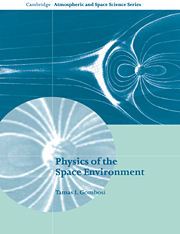Chapter 10 - The Ionosphere
Published online by Cambridge University Press: 22 October 2009
Summary
There are ions and electrons at all altitudes of the terrestrial atmosphere. Below about 60 km thermal charged particles (which have comparable energies to the neutral gas constituents) do not play any significant role in determining the chemical or physical properties of the atmosphere. Above ≈60 km, however, the presence of electrons and ions becomes increasingly important. This region of the upper atmosphere is called the ionosphere. Note that the ionosphere overlaps with the upper mesosphere, the thermosphere, and the geocorona.
The typical vertical structure of the ionosphere is shown in Figure 10.1 (Hargreaves 1992). Inspection of Figure 10.1 reveals that the ionosphere exhibits a strong diurnal variation and it also varies with the solar cycle. The identification of the atmospheric layers is usually related to inflection points in the vertical density profile: The main regions are local minimums. The primary ionospheric regions are the following:
D region (≈60–90 km, peaks around 90 km);
E region (≈90–140 km, peaks around 110 km);
F1 region (≈140–200 km, peaks around 200 km);
F2 region (≈200–500 km, peaks around 300 km);
Topside ionosphere (above the F2 region).
It can be seen that the D and F1 regions disappear at night, while the E and F2 regions become much weaker.
- Type
- Chapter
- Information
- Physics of the Space Environment , pp. 176 - 208Publisher: Cambridge University PressPrint publication year: 1998



